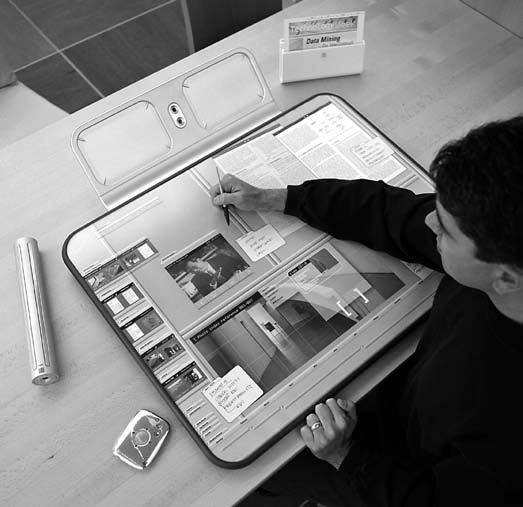
3 minute read
Crafting Interactions Through Design Thinking
CCrafting Interactions Through Design Thinking
“C rafting interactions” is how Danny Stillion describes his work with IDEO, which is internationally known for its innovative “think to build” approach to service, environment, space and customer experience design.
Advertisement
Stillion completed his master’s degree in product design (with a concentration in graphic design) in 1992. In 1996, he joined IDEO in London as a senior interaction designer, after teaching at East Carolina University and consulting. He serves as a Design Director based at the company’s headquarters located in Palo Alto, California.
IDEO has a tradition of human-centeredness that its employees keep in their minds throughout the design process. Armed with knowledge gained from spending time with potential users of products or services, IDEO teams then use synthesis techniques to discover key
opportunity areas and then visualize concepts to share and refine with users to provide a methodology for brainstorming.
“Many businesses know their problem, but don’t know what to do next,” Stillion says. “The humancentered approach of qualitative research recognizes rich ideas and patterns that inspire the design process.” Design thinking overall at IDEO takes place by considering what people find desirable, what is feasible from a business point of view and what is technically feasible.
The most rewarding result is the impact of bringing ideas and great implementation together. Health projects are especially inspiring to him. “Knowing that your work is helping someone with life-giving support or perhaps assisting with spinal surgery is fulfilling,” he says. Stillion feels his graduate work at NC State prepared him well for his career. The faculty were open to new things. He credits Kermit Bailey and Andrew Blauvelt, who was a lecturer while he was in school and is now at The Walker. Both taught key studios that were influential to him. He also gained a perspective and respect for computer programming from taking courses with John Tector.

“The faculty did a great job of being flexible to accommodate my exploring the potential of interactive media,” Stillion says. “I took a computer programming class to pick up some basic programming skills and I was in the first class to work with Hypercard/Director.” From there I continued exploring interaction design within my thesis work.
One faculty member was particularly influential for Stillion. “Meredith Davis was a great inspiration and support for me. With her unique perspective regarding design for education, she helped shape my approach to designing for interactive experiences by considering multiple learner types,” says Stillion.

Opposite page: Integrated industrial and interaction design language for Intermec. Clockwise: Conceptual future products exploration. Cisco’s internet-based telephone system. Dental cavity detection and treatment system. Visualizing hightech's human-centered future. Concept for team work space based on globe design for Steelcase in Chicago. Stillion has been able to return to NC State in order to share his own experience with design students. He came to the College of Design as a visiting lecturer for the Ph.D. and master of graphic design students in February 2008. The topics he discussed included how to get feedback on ideas and how to translate the feedback into designs.
Learning how to make the most of feedback is an important skill for designers, Stillion believes. Validation with users is sometimes humbling for designers, he explains. At IDEO, teams sometimes use what is referred to as “unfocus groups” with users, which are informal and generative so he discussed using this technique while visiting the college.
Storytelling is also an important part of design thinking. Stillion never tires of being inspired by users and inspiring people through the resulting humancentered designs that emerge from the design thinking that takes place at IDEO. “Design touches everything and we are all capable of design thinking,” he says. He is excited to see a new generation of students doing design thinking and what they will be bringing to the world through their efforts.













